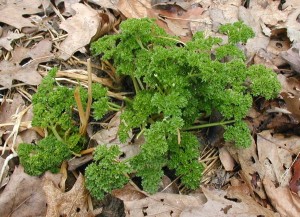The perennial herbs are re-growing quickly this early Spring. Some of our returning herbs are in the vegetable garden or at the edge of it. Others are in a herb bed in front of the house that receives more sun than those in the garden.
Our list of returning herbs includes –
- thyme
- oregano
- parsley, curled and flat
- tarragon, russian and french
- cilantro or coriander
- chives
- peppermint
- spearmint
- lemon balm
- chamomile
- catnip
The herb I’m missing the most is rosemary. Gotta find a rosemary plant this year. It’s one that doesn’t start well from seed, so I’ll be combing through nursery aisles looking for a plant instead.
All of our herbs are easily accessed from the kitchen and that’s something to keep in mind when you’re planting herbs this year. If your herbs are way in the back of the backyard, or somehow not so accessible, then it’s likely you’ll do without them in your cooking. Our herbs are but a few steps away from the kitchen, so even in the middle of cooking dinner I can walk out there, snip a few springs of oregano or thyme and be back inside before anything gets too crispy.
So far this Spring I’ve used the tarragons, parsley, thyme, chives and lemon balm. What herbs have you used from your re-growing herb garden?

![Reblog this post [with Zemanta]](http://img.zemanta.com/reblog_e.png?x-id=9f08bc26-d63b-48b9-a7d3-ae94dc15c1ae)